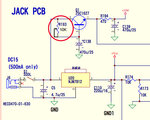Allachikatillo
Newbie level 5
Hi!
I'm trying to clone vestax from original circuit for my study project. Made the PCBs, but it doesn't work properly. The volume is low, pots doesn't much effect the sound (completely turned down pots still sending signal) and phones doesn't work as well. Removing H7C connection, totally removing U7 from the socket or that transistor 2sc1627 do nothing. Capacitor polarity is right. Shorting out the C and E of the 2sc1627 makes U19 working, but U7 distort the sound in phones. It would suggest that the fault is in that part of the circuit causing it to draw too much current. Its about 1,2V on the E, C is 15V measured to ground, B to E is 9V, E to C is 14V. No matter with or without "To Phones" load connection. U7 V+ pin is 1,2 V. Every Cap is wright oriented, and PCBs is without solder bridges.
I've checked the pcb and everything is connected right.
The solving this problem doesn't mean the solving problem of the whole circuit. The question is why the original circuit doesn't work as it should be. Changing the transistor or supply part doesn't solve the problem with pots (i use this https://lib.chipdip.ru/995/DOC000995779.pdf, every pot is well grounded). I think something is causing all this problems, but can't find it.
I surmise thats its all about GND or supply in general. I have 2 PCBs with separated ground planes with single point ground connection for GND, GND1 and GND3 (the second PCB).
Maybe I misread the schematic and make a mistake with layout? What should I check or re-check, to find the problem?
- - - Updated - - -
UPD: Strange thing happen - if i totally disconnect GND2 point on H2C/CN2J the LED11 (Power Led) is still working (while the pwr is on). How it can be explained, there is no any GND connection on this board.
I'm trying to clone vestax from original circuit for my study project. Made the PCBs, but it doesn't work properly. The volume is low, pots doesn't much effect the sound (completely turned down pots still sending signal) and phones doesn't work as well. Removing H7C connection, totally removing U7 from the socket or that transistor 2sc1627 do nothing. Capacitor polarity is right. Shorting out the C and E of the 2sc1627 makes U19 working, but U7 distort the sound in phones. It would suggest that the fault is in that part of the circuit causing it to draw too much current. Its about 1,2V on the E, C is 15V measured to ground, B to E is 9V, E to C is 14V. No matter with or without "To Phones" load connection. U7 V+ pin is 1,2 V. Every Cap is wright oriented, and PCBs is without solder bridges.
I've checked the pcb and everything is connected right.
The solving this problem doesn't mean the solving problem of the whole circuit. The question is why the original circuit doesn't work as it should be. Changing the transistor or supply part doesn't solve the problem with pots (i use this https://lib.chipdip.ru/995/DOC000995779.pdf, every pot is well grounded). I think something is causing all this problems, but can't find it.
I surmise thats its all about GND or supply in general. I have 2 PCBs with separated ground planes with single point ground connection for GND, GND1 and GND3 (the second PCB).
Maybe I misread the schematic and make a mistake with layout? What should I check or re-check, to find the problem?
- - - Updated - - -
UPD: Strange thing happen - if i totally disconnect GND2 point on H2C/CN2J the LED11 (Power Led) is still working (while the pwr is on). How it can be explained, there is no any GND connection on this board.
